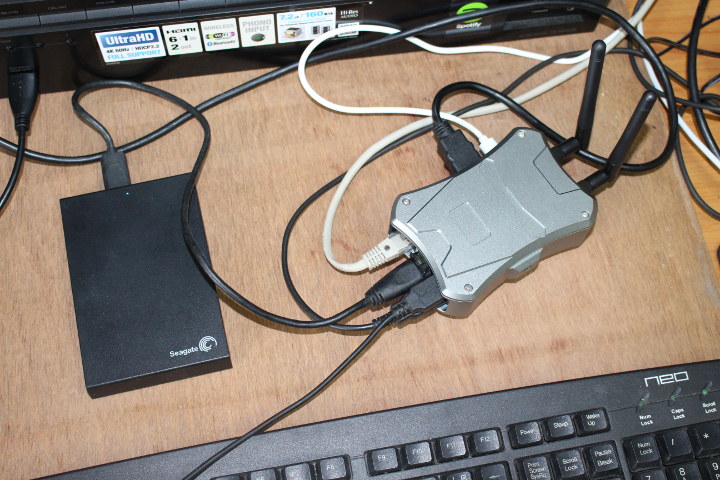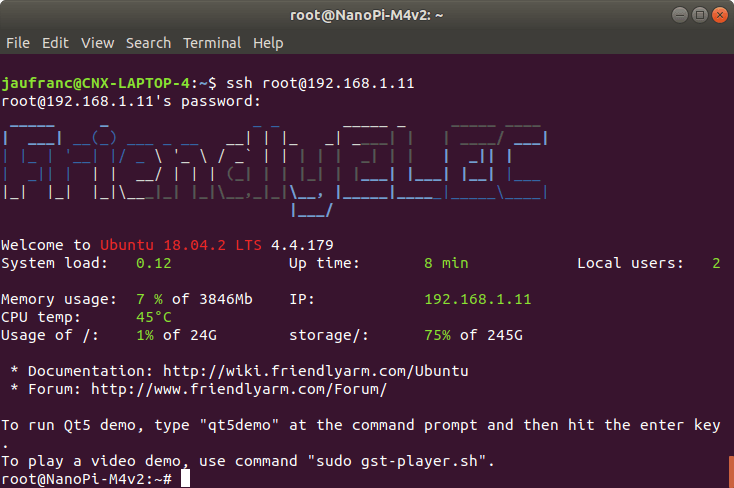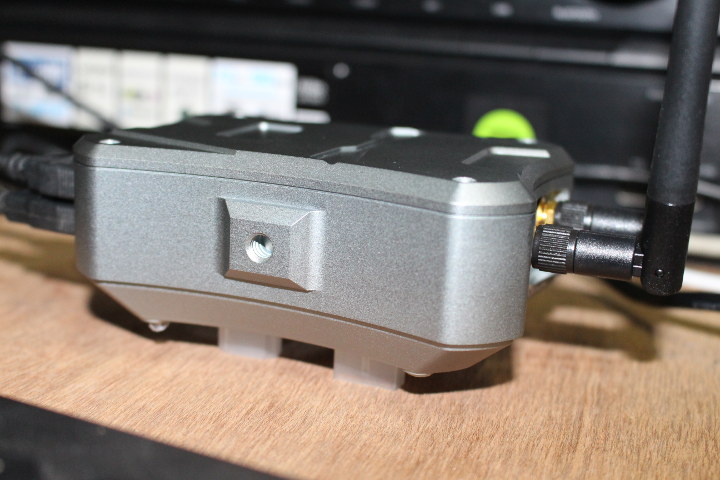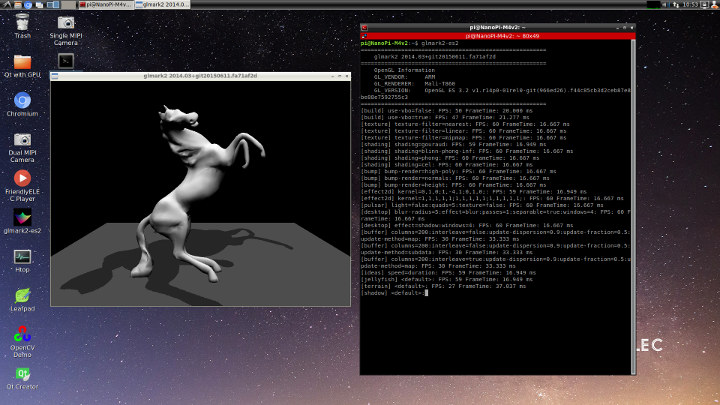We’ve already seen how to assemble NanoPi M4V2 metal case kit which offers an Arm mini PC solution with support for NVMe SSD. The new NanoPi M4V2 Rockchip RK3399 SBC is an evolution of the M4 board that brings faster LPDDR4 memory and adds power & recovery buttons.
Since we’ve already tested several RK3399 SBC‘s and TV boxes, I planned to focus the review on thermal design evaluation (i.e. see how well the board cools), and see how memory bandwidth evolved from LPDDR3 to LPDDR4.
I wanted to do so both with Linux and Android, since I could compare NanoPC-T4 (LPDDR3) benchmarks in Android. But this requires an eMMC flash module, and I don’t own any. So instead I planned to run Armbian because of support for armbian-monitor for nice temperature chart but it’s not working just yet, so instead I’ve done all tests with FriendlyCore Desktop (rk3399-sd-friendlydesktop-bionic-4.4-arm64-20190926.img) based on Ubuntu 18.04.
System Information
The desktop environment will auto-login, but if you want to login over SSH you can use root username and fa password. Just a few details about the system:
|
1 2 3 4 5 6 7 8 9 10 11 12 13 14 15 16 17 18 19 20 21 22 23 24 25 26 |
root@NanoPi-M4v2:~# uname -a Linux NanoPi-M4v2 4.4.179 #1 SMP Thu Aug 29 17:08:23 CST 2019 aarch64 aarch64 aarch64 GNU/Linux root@NanoPi-M4v2:~# cat /etc/lsb-release DISTRIB_ID=Ubuntu DISTRIB_RELEASE=18.04 DISTRIB_CODENAME=bionic DISTRIB_DESCRIPTION="Ubuntu 18.04.2 LTS" root@NanoPi-M4v2:~# df -h Filesystem Size Used Avail Use% Mounted on udev 1.9G 0 1.9G 0% /dev tmpfs 385M 1.1M 384M 1% /run overlay 24G 761M 23G 4% / tmpfs 1.9G 0 1.9G 0% /dev/shm tmpfs 5.0M 4.0K 5.0M 1% /run/lock tmpfs 1.9G 0 1.9G 0% /sys/fs/cgroup tmpfs 385M 12K 385M 1% /run/user/1000 /dev/sda4 200G 174G 24G 89% /media/pi/USB3_BTRFS /dev/sda3 245G 163G 82G 67% /media/pi/USB3_EXFAT /dev/sda2 241G 181G 48G 80% /media/pi/USB3_EXT4 /dev/sda1 245G 182G 63G 75% /media/pi/USB3_NTFS /dev/mmcblk0p2 24G 761M 23G 4% /media/pi/userdata tmpfs 385M 0 385M 0% /run/user/0 root@NanoPi-M4v2:~# free -h total used free shared buff/cache available Mem: 3.8G 260M 2.3G 17M 1.2G 3.3G Swap: 0B 0B 0B |
Note I connected my USB 3.0 test hardware as well which explains the four /dev/sda1..4 partitions.
Loaded modules:
|
1 2 3 4 5 6 7 8 9 10 11 12 13 14 15 |
root@NanoPi-M4v2:~# lsmod Module Size Used by btrfs 995328 1 xor 20480 1 btrfs raid6_pq 102400 1 btrfs joydev 20480 0 sg 40960 0 bcmdhd 1314816 0 binfmt_misc 20480 1 uio_pdrv_genirq 16384 0 uio 20480 1 uio_pdrv_genirq sch_fq_codel 20480 3 bnep 24576 2 ip_tables 28672 0 x_tables 36864 1 ip_tables |
GPIOs appear to be properly configured:
|
1 2 3 4 5 6 7 8 9 10 11 12 13 14 15 16 17 18 19 20 21 22 23 24 25 26 27 |
root@NanoPi-M4v2:~# ls /sys/class/gpio/ export gpiochip0 gpiochip128 gpiochip32 gpiochip64 gpiochip96 unexport root@NanoPi-M4v2:~# cat /sys/kernel/debug/gpio GPIOs 0-31, platform/pinctrl, gpio0: gpio-1 ( |vcc_sd ) out hi gpio-4 ( |bt_default_wake_host) in hi gpio-5 ( |GPIO Key Power ) in hi gpio-9 ( |bt_default_reset ) out hi gpio-10 ( |reset ) out hi gpio-13 ( |? ) out lo GPIOs 32-63, platform/pinctrl, gpio1: gpio-34 ( |int-n ) in hi gpio-46 ( |vsel ) out lo gpio-49 ( |vsel ) out lo GPIOs 64-95, platform/pinctrl, gpio2: gpio-83 ( |bt_default_rts ) out lo gpio-90 ( |bt_default_wake ) out hi GPIOs 96-127, platform/pinctrl, gpio3: gpio-111 ( |mdio-reset ) out hi GPIOs 128-159, platform/pinctrl, gpio4: gpio-154 ( |vbus-5v ) out lo gpio-157 ( |enable ) out lo gpio-158 ( |vcc_lcd ) out lo |
SBC Bench
SBC Bench script is great to benchmark Arm SBC’s and check if CPU throttling occurs under various workloads, So let’s install it:
|
1 2 3 4 5 |
wget https://raw.githubusercontent.com/ThomasKaiser/sbc-bench/master/sbc-bench.sh chmod +x sbc-bench.sh root@NanoPi-M4v2:~# ./sbc-bench.sh -m Time big.LITTLE load %cpu %sys %usr %nice %io %irq Temp 07:48:27: 1008/1416MHz 0.08 1% 0% 0% 0% 0% 0% 51.7°C |
The system reports the CPU temperature is 51.7°C at idle, and I measured around 41°C on the top of the enclosure with an IR thermometer. The ambient temperature was around 28-29°C. Note that I do not have any NVMe SSD, and if you do use one temperature may be slightly higher. There’s a fan which will only rotate when the temperature rises further, and when it does it’s really noisy in a way I can hear in another room (if the door is opened) about 6 meters away from the board.
Time to run the benchmarks. It will take a while.
|
1 2 3 4 5 6 7 8 9 10 11 12 13 14 15 16 17 18 19 20 21 22 23 24 25 26 27 28 29 30 31 32 33 34 35 36 37 |
./sbc-bench.sh -c sbc-bench v0.6.9 Installing needed tools. This may take some time... Done. Checking cpufreq OPP... Done. Executing tinymembench. This will take a long time... Done. Executing OpenSSL benchmark. This will take 3 minutes... Done. Executing 7-zip benchmark. This will take a long time... Done. Executing cpuminer. This will take 5 minutes... Done. Checking cpufreq OPP... Done. ATTENTION: Throttling might have occured on CPUs 0-3. Check the log for details. ATTENTION: Throttling might have occured on CPUs 4-5. Check the log for details. Memory performance (big.LITTLE cores measured individually): memcpy: 1302.1 MB/s (0.5%) memset: 4654.9 MB/s (0.4%) memcpy: 2613.9 MB/s (0.7%) memset: 4758.7 MB/s (0.8%) Cpuminer total scores (5 minutes execution): 7.82,7.76,7.75,7.73,7.71,7.70,7.69,7.64,7.63,7.62,7.61,7.60,7.57,7.56,7.54,7.53,7.51,7.49,7.48,7.46,7.45,7.44,7.42,7.41,7.40,7.37,7.36,7.34,7.32,7.29,7.28,7.26,7.25,7.24,7.23,7.22,7.21,7.20,7.19,7.18,7.17 kH/s 7-zip total scores (3 consecutive runs): 5875,5492,5560 OpenSSL results (big.LITTLE cores measured individually): type 16 bytes 64 bytes 256 bytes 1024 bytes 8192 bytes 16384 bytes aes-128-cbc 124065.11k 368155.37k 705491.20k 947014.31k 1052090.37k 1058908.84k aes-128-cbc 358389.56k 807787.75k 1159997.95k 1278035.63k 1345746.26k 1347988.14k aes-192-cbc 118232.62k 327556.91k 576749.91k 730951.34k 791800.49k 795858.26k aes-192-cbc 337263.40k 739913.49k 980548.69k 1132787.71k 1185980.42k 1185147.56k aes-256-cbc 114553.00k 300478.08k 499657.81k 611518.12k 653445.80k 654939.48k aes-256-cbc 325593.91k 660635.97k 904857.86k 977412.78k 1017637.55k 1018451.29k Full results uploaded to http://ix.io/1ZWO. Please check the log for anomalies (e.g. swapping or throttling happenend) and otherwise share this URL. |
I also had ./sbc-bench -m running in a separate window to monitor the temperature more often, and the CPU temperature rose up to 71.1°C. The top of the enclosure was only slightly warmer 42°C.
CPU Throttling
No problem for single-core benchmark, but we can see a tiny bit of throttling for 7zip multi-thread benchmark:
|
1 2 3 4 5 6 7 8 9 10 11 12 13 14 |
System health while running 7-zip multi core benchmark: Time big.LITTLE load %cpu %sys %usr %nice %io %irq Temp 09:47:58: 1800/1416MHz 4.60 3% 0% 2% 0% 0% 0% 59.4°C 09:48:19: 1800/1416MHz 5.06 79% 1% 77% 0% 0% 0% 67.8°C 09:48:40: 1800/1416MHz 5.18 77% 1% 76% 0% 0% 0% 66.7°C 09:49:00: 1800/1416MHz 5.76 90% 1% 88% 0% 0% 0% 69.4°C 09:49:20: 1800/1416MHz 5.52 73% 1% 72% 0% 0% 0% 67.8°C 09:49:40: 1800/1416MHz 5.51 84% 1% 82% 0% 0% 0% 69.4°C 09:50:00: 1800/1416MHz 5.80 78% 1% 76% 0% 0% 0% 69.4°C 09:50:21: 1008/1416MHz 6.21 92% 1% 90% 0% 0% 0% 70.6°C 09:50:44: 1800/1416MHz 5.92 78% 1% 76% 0% 0% 0% 70.0°C 09:51:05: 1800/1416MHz 5.88 81% 1% 79% 0% 0% 0% 67.2°C 09:51:25: 1800/1416MHz 5.90 87% 2% 85% 0% 0% 0% 70.0°C |
but it happens much more frequently with cpuminer:
|
1 2 3 4 5 6 7 8 9 10 11 12 13 14 15 16 |
System health while running cpuminer: Time big.LITTLE load %cpu %sys %usr %nice %io %irq Temp 09:51:38: 600/1200MHz 5.77 4% 0% 3% 0% 0% 0% 68.9°C 09:52:02: 1800/1200MHz 5.96 100% 1% 98% 0% 0% 0% 68.9°C 09:52:26: 1008/1200MHz 6.03 100% 1% 98% 0% 0% 0% 70.6°C 09:52:50: 600/1200MHz 6.02 100% 1% 98% 0% 0% 0% 69.4°C 09:53:14: 1800/1200MHz 6.15 100% 1% 98% 0% 0% 0% 68.3°C 09:53:38: 1800/1008MHz 6.23 100% 1% 98% 0% 0% 0% 68.9°C 09:54:02: 408/1416MHz 6.21 100% 1% 98% 0% 0% 0% 70.6°C 09:54:26: 600/1416MHz 6.19 100% 1% 98% 0% 0% 0% 69.4°C 09:54:50: 1800/1416MHz 6.21 100% 1% 98% 0% 0% 0% 68.9°C 09:55:14: 600/1416MHz 6.15 100% 1% 98% 0% 0% 0% 68.3°C 09:55:38: 600/1416MHz 6.29 100% 1% 98% 0% 0% 0% 70.0°C 09:56:03: 600/1008MHz 6.24 100% 1% 98% 0% 0% 0% 70.0°C 09:56:28: 1800/1008MHz 6.22 100% 1% 98% 0% 0% 0% 71.1°C |
It looks as if the system will drop the clock speed of the big cores to around 600 MHz when the CPU temperature goes over 70°C.
Memory Bandwidth
NanoPi M4 results for the big cores (2x Arm Cortex-A72) taken from SBC-Bench results database:
- memcpy: 4080 MB/s
- memset: 8270 MB/s
So now we have software/configuration issues on our hands as NanoPi M4V2 with the supposedly faster memory is actually much slower:
- memcpy: 2613.9 MB/s
- memset: 4758.7 MB/s
M4V2 runs Ubuntu 18.04 64-bit with Linux 4.4 while the M4 board was tested with Debian Stretch 64-bit and Linux 4.19. Here’s the kernel boot log for reference, but I can’t see anything about ddr.
Improving Air Flow
The way the case is designed the fan faces the desktop, and the case is only slightly elevated via rubber pads. One way to potentially improve cooling is to turn the enclosure upside down with the fan facing up, but instead, I elevated the case with four HDMI connector caps.
Let’s repeat the test:
|
1 2 3 4 5 6 7 8 9 10 11 12 13 14 15 16 17 18 19 20 21 22 23 24 25 26 27 28 29 30 31 32 33 34 35 36 37 38 39 40 41 42 |
./sbc-bench.sh -c Average load is 0.1 or higher (way too much background activity). Waiting... System too busy for benchmarking: 13:22:38 up 8:29, 5 users, load average: 0.11, 1.08, 2.41 System too busy for benchmarking: 13:22:43 up 8:29, 5 users, load average: 0.10, 1.06, 2.39 sbc-bench v0.6.9 Installing needed tools. This may take some time... Done. Checking cpufreq OPP... Done. Executing tinymembench. This will take a long time... Done. Executing OpenSSL benchmark. This will take 3 minutes... Done. Executing 7-zip benchmark. This will take a long time... Done. Executing cpuminer. This will take 5 minutes... Done. Checking cpufreq OPP... Done. ATTENTION: Throttling might have occured on CPUs 0-3. Check the log for details. ATTENTION: Throttling might have occured on CPUs 4-5. Check the log for details. Memory performance (big.LITTLE cores measured individually): memcpy: 1336.6 MB/s (0.6%) memset: 4675.6 MB/s memcpy: 2594.7 MB/s (0.9%) memset: 4790.5 MB/s (0.6%) Cpuminer total scores (5 minutes execution): 9.51,9.42,8.89,8.72,8.63,8.59,8.58,8.53,8.52,8.48,8.47,8.44,8.43,8.42,8.40,8.39,8.38,8.37,8.36,8.34,8.29,8.28,8.26,8.23,8.22,8.21,8.19,8.18,8.17,8.16,8.15,8.14,8.12,8.11,8.10,8.09 kH/s 7-zip total scores (3 consecutive runs): 6097,6091,6131 OpenSSL results (big.LITTLE cores measured individually): type 16 bytes 64 bytes 256 bytes 1024 bytes 8192 bytes 16384 bytes aes-128-cbc 124053.61k 368255.06k 706825.39k 947712.34k 1052890.45k 1058805.08k aes-128-cbc 358191.40k 807757.33k 1160006.83k 1282757.29k 1342816.26k 1348059.14k aes-192-cbc 118253.40k 326713.71k 577089.45k 730836.31k 792005.29k 796027.56k aes-192-cbc 337222.84k 739990.25k 984173.23k 1131525.12k 1186556.59k 1189811.54k aes-256-cbc 114629.87k 301376.96k 499779.24k 611570.69k 653781.67k 655742.29k aes-256-cbc 325630.63k 670746.20k 904601.77k 977996.46k 1017951.57k 1013841.92k Full results uploaded to http://ix.io/1ZYx. Please check the log for anomalies (e.g. swapping or throttling happenend) and otherwise share this URL. |
Sadly throttling still occurred but there are still some improvements since it did not happen with 7-zip at all (4°C lower), and happened less often with cpuminer:
|
1 2 3 4 5 6 7 8 9 10 11 12 13 14 15 16 17 18 19 20 21 22 23 24 25 26 27 28 29 30 31 |
System health while running 7-zip multi core benchmark: Time big.LITTLE load %cpu %sys %usr %nice %io %irq Temp 14:02:16: 1800/1416MHz 4.64 7% 0% 7% 0% 0% 0% 55.0°C 14:02:37: 1800/1416MHz 4.89 77% 0% 76% 0% 0% 0% 64.4°C 14:02:57: 1800/1416MHz 4.55 75% 1% 74% 0% 0% 0% 59.4°C 14:03:17: 1800/1416MHz 4.89 91% 1% 90% 0% 0% 0% 62.5°C 14:03:37: 1800/1416MHz 4.54 70% 0% 69% 0% 0% 0% 63.8°C 14:03:58: 1800/1416MHz 4.64 82% 1% 80% 0% 0% 0% 62.5°C 14:04:18: 1800/1416MHz 4.61 77% 1% 75% 0% 0% 0% 63.1°C 14:04:38: 1800/1416MHz 4.68 81% 1% 80% 0% 0% 0% 63.8°C 14:04:58: 1800/1416MHz 4.81 82% 1% 81% 0% 0% 0% 65.0°C 14:05:18: 1800/1416MHz 5.06 79% 1% 78% 0% 0% 0% 63.1°C 14:05:41: 1800/1416MHz 5.39 86% 1% 84% 0% 0% 0% 66.1°C System health while running cpuminer: Time big.LITTLE load %cpu %sys %usr %nice %io %irq Temp 14:05:45: 1800/1416MHz 5.52 8% 0% 7% 0% 0% 0% 68.3°C 14:06:08: 1800/1416MHz 5.89 100% 0% 99% 0% 0% 0% 67.8°C 14:06:31: 1800/1416MHz 5.92 100% 0% 99% 0% 0% 0% 68.9°C 14:06:53: 1800/1416MHz 6.06 100% 0% 99% 0% 0% 0% 68.9°C 14:07:16: 1800/1416MHz 6.04 100% 0% 99% 0% 0% 0% 69.4°C 14:07:39: 1800/1416MHz 6.09 100% 0% 99% 0% 0% 0% 68.9°C 14:08:02: 1800/1416MHz 6.06 100% 0% 99% 0% 0% 0% 70.0°C 14:08:25: 1800/1416MHz 6.10 100% 0% 99% 0% 0% 0% 70.0°C 14:08:48: 1800/1416MHz 6.19 100% 0% 99% 0% 0% 0% 69.4°C 14:09:12: 1800/1416MHz 6.14 100% 0% 99% 0% 0% 0% 67.2°C 14:09:35: 1800/ 600MHz 6.15 100% 0% 99% 0% 0% 0% 68.9°C 14:09:59: 408/ 600MHz 6.15 100% 0% 99% 0% 0% 0% 70.0°C 14:10:22: 1800/1416MHz 6.11 100% 0% 99% 0% 0% 0% 70.0°C |
GPU Acceleration and VPU Hardware Decoding
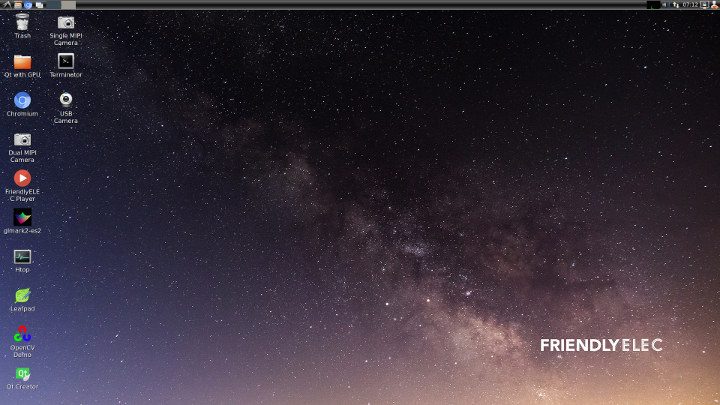
FriendlyCore comes with a set of programs preinstalled including some that allow us to test whether 3D graphics acceleration and hardware video decoding work.
glmark2-es2 is preinstalled and runs fine…
But the glmark2 score is on the low side at 54 because, as I understand it, vsync is enabled so the maximum score is 60 fps:
|
1 2 3 4 5 6 7 8 9 10 11 12 13 14 15 16 17 18 19 20 21 22 23 24 25 26 27 28 29 30 31 32 33 34 35 36 37 38 39 40 41 42 43 44 45 |
pi@NanoPi-M4v2:~$ glmark2-es2 ======================================================= glmark2 2014.03+git20150611.fa71af2d ======================================================= OpenGL Information GL_VENDOR: ARM GL_RENDERER: Mali-T860 GL_VERSION: OpenGL ES 3.2 v1.r14p0-01rel0-git(966ed26).f44c85cb3d2ceb87e8be88e7592755c3 ======================================================= [build] use-vbo=false: FPS: 50 FrameTime: 20.000 ms [build] use-vbo=true: FPS: 47 FrameTime: 21.277 ms [texture] texture-filter=nearest: FPS: 60 FrameTime: 16.667 ms [texture] texture-filter=linear: FPS: 60 FrameTime: 16.667 ms [texture] texture-filter=mipmap: FPS: 60 FrameTime: 16.667 ms [shading] shading=gouraud: FPS: 59 FrameTime: 16.949 ms [shading] shading=blinn-phong-inf: FPS: 60 FrameTime: 16.667 ms [shading] shading=phong: FPS: 60 FrameTime: 16.667 ms [shading] shading=cel: FPS: 60 FrameTime: 16.667 ms [bump] bump-render=high-poly: FPS: 60 FrameTime: 16.667 ms [bump] bump-render=normals: FPS: 60 FrameTime: 16.667 ms [bump] bump-render=height: FPS: 60 FrameTime: 16.667 ms [effect2d] kernel=0,1,0;1,-4,1;0,1,0;: FPS: 59 FrameTime: 16.949 ms [effect2d] kernel=1,1,1,1,1;1,1,1,1,1;1,1,1,1,1;: FPS: 60 FrameTime: 16.667 ms [pulsar] light=false:quads=5:texture=false: FPS: 60 FrameTime: 16.667 ms [desktop] blur-radius=5:effect=blur:passes=1:separable=true:windows=4: FPS: 60 FrameTime: 16.667 ms [desktop] effect=shadow:windows=4: FPS: 60 FrameTime: 16.667 ms [buffer] columns=200:interleave=false:update-dispersion=0.9:update-fraction=0.5:update-method=map: FPS: 30 FrameTime: 33.333 ms [buffer] columns=200:interleave=false:update-dispersion=0.9:update-fraction=0.5:update-method=subdata: FPS: 30 FrameTime: 33.333 ms [buffer] columns=200:interleave=true:update-dispersion=0.9:update-fraction=0.5:update-method=map: FPS: 30 FrameTime: 33.333 ms [ideas] speed=duration: FPS: 59 FrameTime: 16.949 ms [jellyfish] <default>: FPS: 59 FrameTime: 16.949 ms [terrain] <default>: FPS: 27 FrameTime: 37.037 ms [shadow] <default>: FPS: 57 FrameTime: 17.544 ms [refract] <default>: FPS: 32 FrameTime: 31.250 ms [conditionals] fragment-steps=0:vertex-steps=0: FPS: 60 FrameTime: 16.667 ms [conditionals] fragment-steps=5:vertex-steps=0: FPS: 60 FrameTime: 16.667 ms [conditionals] fragment-steps=0:vertex-steps=5: FPS: 60 FrameTime: 16.667 ms [function] fragment-complexity=low:fragment-steps=5: FPS: 60 FrameTime: 16.667 ms [function] fragment-complexity=medium:fragment-steps=5: FPS: 60 FrameTime: 16.667 ms [loop] fragment-loop=false:fragment-steps=5:vertex-steps=5: FPS: 59 FrameTime: 16.949 ms [loop] fragment-steps=5:fragment-uniform=false:vertex-steps=5: FPS: 60 FrameTime: 16.667 ms [loop] fragment-steps=5:fragment-uniform=true:vertex-steps=5: FPS: 60 FrameTime: 16.667 ms ======================================================= glmark2 Score: 54 ======================================================= |
I could test 4K video playback in FriendlyELEC Player and I was able to play H.265, H.264 and VP9 videos with hardware video decoding.

However .ts files won’t play at all, and as such, I could not play any 10-bit H.264 nor 10-bit H.265 4K videos since all my samples are based on TS container format. I was also unable to change the display resolution from 1920×1080 to 4K resolutions such as 3840×2160 or 4196×2160 since those were simply not detected despite being connected to a 4K TV.
Qt Development & Demos
I could not help but also notice the Qt demos on the desktop. There was also an OpenCV demo but it requires a USB or MIPI camera and I could not find my USB webcam.
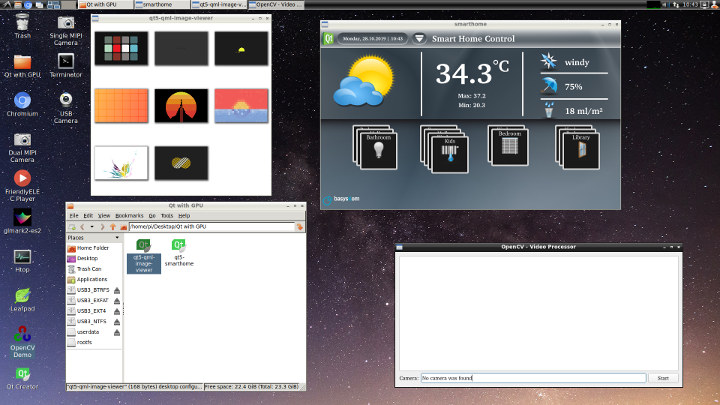
The Qt5 QML demos include an image browser and a smart hone UI. If you want to easily get started with Qt UI development on Arm, FriendlyELEC has a “Develop Qt Applications” section in their wiki so NanoPI M4/M4V2 may be a good starting point. They also have several Qt repositories with demos in their GitHub account.
Final words
NanoPi M4V2 metal case kit does the job at keeping the Rockchip RK3399 board cool enough in most conditions. But you must be aware the fan is really noisy when it kicks off, and I did not test the kit with an NVMe SSD which may further generate heat.
If you plan to use Android, you’ll need to purchase an additional eMMC flash module, but with FriendlyCore Desktop tested above a MicroSD card will suffice. I used a 32GB class A1 MicroSD card and performance was satisfactory. The software appears to be fairly solid and should be a good base for product development. There may be further tweaks needed to extra more performance, as we’ve found out memory bandwidth was about half of boards with DDR3 memory.
If you’d like to purchase the hardware used for this review you can do so for $98 plus shipping Just make sure to also select “Metal Case w/ Cooling Fan(NVMe SSD Adapter included) (+$28.00)” option.

Jean-Luc started CNX Software in 2010 as a part-time endeavor, before quitting his job as a software engineering manager, and starting to write daily news, and reviews full time later in 2011.
Support CNX Software! Donate via cryptocurrencies, become a Patron on Patreon, or purchase goods on Amazon or Aliexpress


